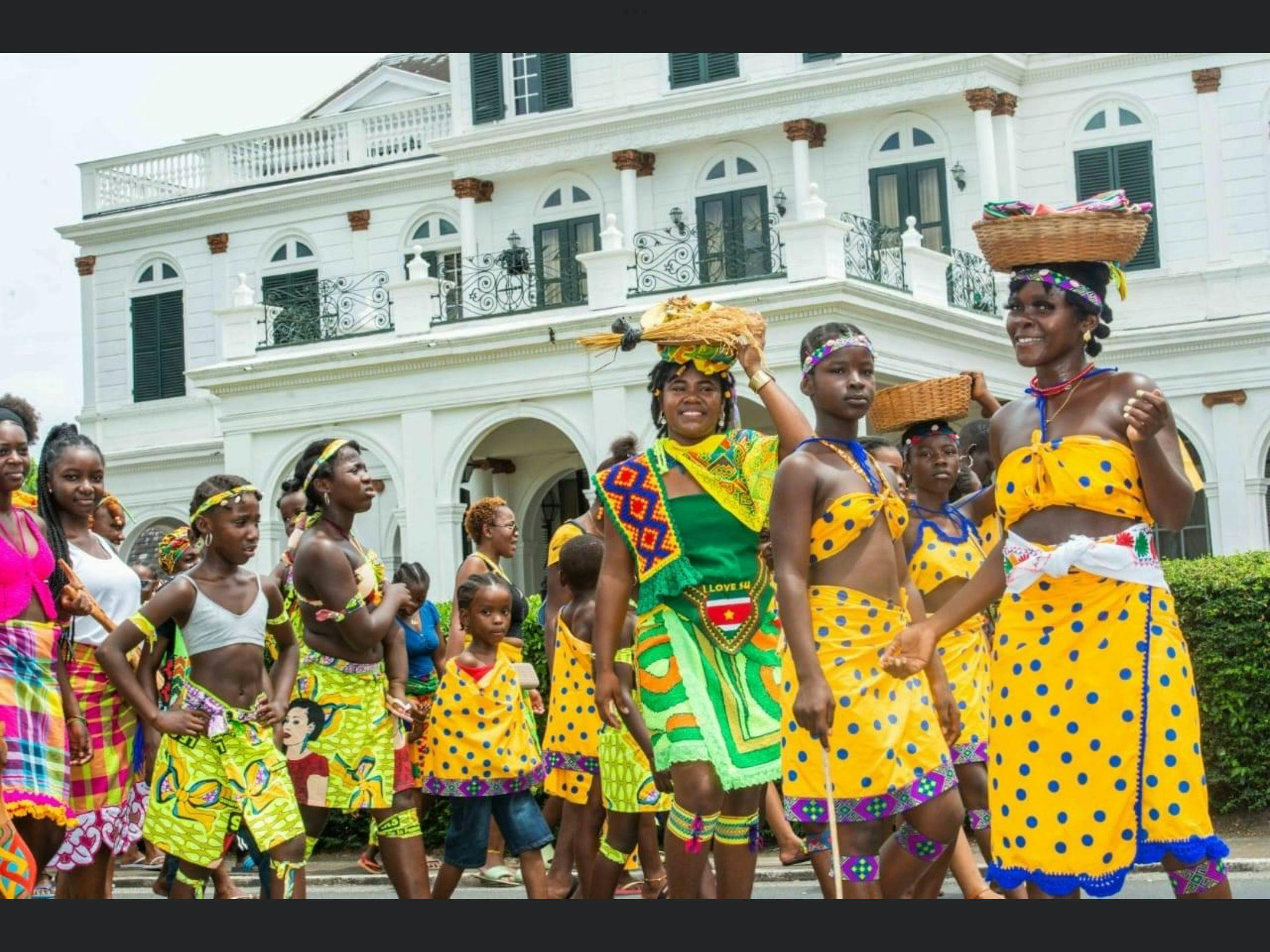Soengoe Kondre / Submerged Heritage
15 September 2023 - 1 June 2024
A special aseisente-pangi at the exhibition
Joney Doekoe, director of the Saamaka Museum in Suriname, has designed a special aseisente-pangi especially for the exhibition Soengoe Kondre / Submerged Heritage at the Nieuwe Instituut. This unique piece of clothing is available at the NAi Booksellers shop in the foyer of the institute. The pangis are handmade to order and cost €50 each. All proceeds go to the Saamaka Museum in the village of Pikin Slee.
Soengoe Kondre / Submerged Heritage
In Soengoe Kondre, curator Vincent van Velsen reconstructs the historical, cultural and political context of the construction of the Afobaka Dam in Suriname. He focuses in particular on the far-reaching consequences of the dam and its reservoir for the Maroon communities. They were forced to move because of the rising water and watched as part of their culture disappeared under the water, along with their homes.
In the epilogue in the last room, Van Velsen pays tribute to the hope, courage and resilience of the Saramakan and Aukan Maroons at the centre of the exhibition, who have faced great adversity for centuries. Their culture reflects this ingenuity and links past, present and future. For example, the Maroons express their history and identity through new translations of traditional costumes into contemporary fashion.
Although the distinctive coloured wraps, worn and knotted in different ways, have become less common as everyday clothing as many Maroons have moved to the city, they continue to be a way for those who wear them to express the identity and heritage of their communities.
We are convinced that the cultural richness, inventiveness, survival instinct and zest for life that have underpinned the culture and lifestyle of these communities for hundreds of years will also enable them to cope with current circumstances.
Joney Doekoe’s aseisente-pangi is designed as a kind of rectangular patchwork of elongated strips in different colours and patterns. Until the 1960s, an aseisente was mainly a garment worn by men, but the word has since become a collective term for all garments made of elongated strips of fabric. These different forms of the aseisente are worn in different ways by both men and women. A pangi, also called a kosoe from the Saramakan word for cloth, is a rectangular piece of fabric. Traditionally, the pangi is worn by women as a wrap skirt. Men wear the similar kamisa as a loincloth or the bandja-koosoe tied diagonally over their shoulders.
A wearable life story
In Maroon communities, pangis are ceremonially exchanged on special occasions such as holidays, the birth of a child, weddings or the death of a family member. The colours, stripes and diamond patterns of the cloth each have their own meaning and reflect such events. Sometimes patterns or designs are given a name, such as the gaama duumi (‘the chief sleeps’), a pangi sold on the death of the gaanman (granman) or chief of the Saramaka.
An aseisente pangi is made from pieces of different pangis, fabrics and clothing that have been collected over the course of a lifetime and which are sewn together to form an aseisente. The moments represented by each individual strip of fabric combine to create a unique wearable life story.
Amoiloeloe aseisente-pangi
The aseisente-pangi you see here is named after its designer, Amoileloe (Joney) Doekoe, director of the Saamaka Museum. Her limited edition Amoileloe aseisente-pangi is available in the NAi Booksellers shop in the foyer.
The continued resilience and ingenuity of the Boni, Kwinti, Matawai, Paamaka and, in this story of submerged heritage in Brokopondo, especially the Saamaka and Ndyuka, is a source of inspiration. Especially now, in times when human and other-than-human life is under increasing pressure from a capitalist system that is exhausting people and nature, we can learn from the way they have defended themselves over the centuries.
Saamaka Museum in Pikin Slee
All proceeds from the exhibition aseisente-pangi will go to the Saamaka Museum. This museum in Pikin Slee on the Upper Suriname River offers space for the past, present and future of the flourishing culture of the Saramakan Maroons, who managed to escape a life of slavery and founded autonomous communities in the interior of Suriname in the 17th century.
For more information (in Dutch) about the museum, visit its website or see a report about the Saamaka Museum from 2022 on the website of the Surinamese daily newspaper De Ware Tijd. Joney Doekoe also contributed to an extensive multimedia background article published by De Volkskrant in 2022 as part of a series of personal stories about the impact of the colonial past on contemporary Dutch society.
For more images and information on the pangi, visit on the Intangible Cultural Heritage website (of the Dutch Centre for Intangible Cultural Heritage), the Surinaams Erfgoed website and the Saamaka Nëngë Instagram account.


